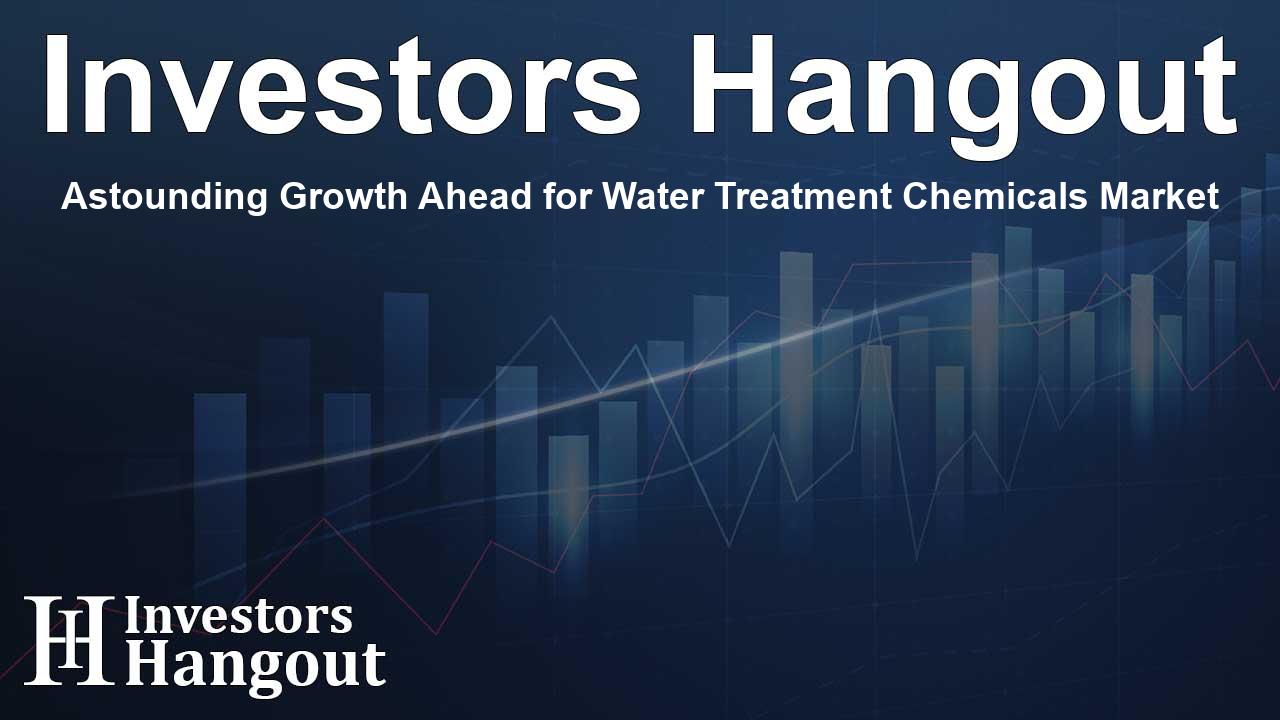Astounding Growth Ahead for Water Treatment Chemicals Market

Significant Market Growth for Water Treatment Chemicals
Austin — According to recent insights from a reputable market report, the water treatment chemicals market exhibited a valuation of USD 46.7 billion in 2023 and is expected to surge to USD 94.2 billion by 2032, growing at a compound annual growth rate (CAGR) of 8.1% during the forecast period from 2024 to 2032.
Market Dynamics and Drivers
The water treatment chemicals market is poised for robust growth globally, particularly with corrosion inhibitors leading the charge. These chemicals prove essential in preventing damage to machinery and equipment across various industries. Rising concerns about sustainability and the urgent need for clean water are propelling this market forward. Recently, technological breakthroughs in filtration, such as those reported by MIT, have emerged, promising to enhance the removal of long-lasting toxic substances from water sources more effectively than traditional methods.
Emerging Innovations in Water Treatment
Among the notable advancements is a recent discovery surrounding a new chemical that enhances the efficacy of water treatment processes, particularly for difficult-to-treat wastewater conditions. Industries increasingly recognize the criticality of innovative solutions in maintaining compliance with environmental regulations, resulting in heightened demand for advanced water treatment chemicals.
Key Players in the Industry
Major players influencing the water treatment chemicals market landscape include Kemira OYJ, Lanxess, DuPont, Akzo Nobel NV, Solenis LLC, Ecolab Inc, Baker Hughes, Suez SA, Lonza Group, and LG Chem Ltd. The combined strengths of these companies foster a competitive environment that drives continuous improvement and innovation in product offerings.
Industrial Applications and Market Segmentation
In terms of market segmentation, the industrial sector accounted for approximately 45% of the total market share in 2023. Industries such as power generation, oil and gas, and manufacturing heavily rely on water treatment chemicals to manage significant wastewater generation and ensure the quality of water utilized in operations. The demand for chemicals such as coagulants, biocides, and corrosion inhibitors is imperative for maintaining optimal performance and compliance with environmental directives.
Continued Focus on Water Quality
Researchers and industries alike are working diligently to address water contamination issues, particularly concerning forever chemicals like PFAS. These substances pose significant environmental and public health risks due to their persistence in water systems. Collaborations among governmental bodies, scientific communities, and public entities are essential to enhance filtration technologies and devise stricter regulatory measures to manage PFAS effectively.
Recent Developments Driving Market Trends
In recent months, strategic advancements from key industry players have shaped the market narrative. For instance, Kemira Oyj announced improvements to its ferric sulfate production facility, addressing the increasing demand due to stricter water regulations in the UK. Similarly, innovative solutions such as micromotors for wastewater treatment, developed by researchers in Spain, showcase the potential for AI-optimized technologies in achieving green energy outputs.
Regional Analysis of Market Dynamics
North America has emerged as a market leader, capturing around 35% of the water treatment chemicals market share in 2023. The region's stringent environmental regulations, alongside significant infrastructure investments, are pivotal to the growth trajectory. Key players, including Ecolab and Kemira, have expanded their research and operational capabilities, reinforcing their market dominance.
Future Outlook
The water treatment chemicals market is expected to experience a transformative phase, prompted by regulatory changes, increased industrialization, and growing environmental consciousness. As industries and municipalities strive for cleaner water solutions, the demand for cutting-edge treatment chemicals is set to rise.
Frequently Asked Questions
What is the projected market size for water treatment chemicals by 2032?
The water treatment chemicals market is expected to reach USD 94.2 billion by 2032.
What is driving the growth of the water treatment chemicals market?
The growth is driven by increasing regulatory pressures, innovations in treatment technologies, and heightened awareness of water quality issues.
Which sectors are the largest consumers of water treatment chemicals?
The industrial sector, particularly energy, manufacturing, and pharmaceuticals, represents the largest consumption of these chemicals.
Who are the key players in the water treatment chemicals market?
Major players include Kemira OYJ, Lanxess, DuPont, Akzo Nobel NV, and Ecolab Inc, among others.
How is the North American market performing in terms of water treatment chemicals?
North America dominated the market in 2023, driven by strict regulations and substantial investments in water treatment infrastructure.
About Investors Hangout
Investors Hangout is a leading online stock forum for financial discussion and learning, offering a wide range of free tools and resources. It draws in traders of all levels, who exchange market knowledge, investigate trading tactics, and keep an eye on industry developments in real time. Featuring financial articles, stock message boards, quotes, charts, company profiles, and live news updates. Through cooperative learning and a wealth of informational resources, it helps users from novices creating their first portfolios to experts honing their techniques. Join Investors Hangout today: https://investorshangout.com/
Disclaimer: The content of this article is solely for general informational purposes only; it does not represent legal, financial, or investment advice. Investors Hangout does not offer financial advice; the author is not a licensed financial advisor. Consult a qualified advisor before making any financial or investment decisions based on this article. The author's interpretation of publicly available data shapes the opinions presented here; as a result, they should not be taken as advice to purchase, sell, or hold any securities mentioned or any other investments. The author does not guarantee the accuracy, completeness, or timeliness of any material, providing it "as is." Information and market conditions may change; past performance is not indicative of future outcomes. If any of the material offered here is inaccurate, please contact us for corrections.